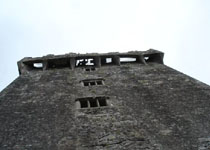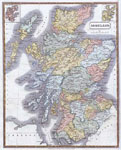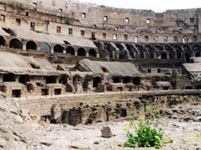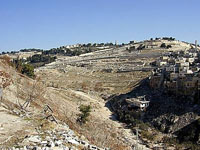
Upon
visiting Ireland, Mrs. R.P. Eaton was graced with beautiful scenery
from Queenstown to Cork. She was able to see the renowned Blarney Stone,
a block of limestone in Blarney Castle that is said to bring the skill
of great eloquence to anyone who kisses it. Throughout the entire journey,
she was able to see both ruined castles and magnificent round towers,
the latter of which were in a good state of preservation.

Because
Mrs. Eaton’s trips were largely fueled by religious motives, she
visited many places of worship. Before arriving to England, she stopped
in Glasgow, Scotland, to see many of its grand Cathedrals and other
places of interest for tourists. After arriving to Liverpool, her first
stop was the house of worship.

The
most striking characteristic of Switzerland, in Mrs. Eaton’s opinion,
was the scenery of the sublime mountains and lakes. Once finally arriving
at the base of the Alpine ranges, she could not help but to recite the
words of Lord Byron, a famous British poet:
Above
me are the Alps,
The palaces of nature, whose vast walls
Above pinnacled in clouds their snowy scalps,
And throned eternity in icy hills
Of cold sublimity, where forms and falls
The avalanche – the thunderbolt of snow!
All that expands the spirit, yet appalls,
How earth may face to heaven, and leave vain man below.

R.P.
Eaton’s fascination with Venice, Italy began with the fact that
the city had its foundation in the sea; there are no sounds of horses
stomping or wheels rolling, but rather gondolas and canals. Venice’s
scenery is very picturesque, but there are also many exhibits for tourists.
Many examples of these lie in St. Mark’s Square. After visiting
Venice, Mrs. Eaton traveled to Milan. Here she was able to see several
churches, in addition to ages worth of sacred architecture in the Milan
Cathedral. Most revered is a statue of the head of the Savior, mainly
because of the expression of both authority and sympathy on His face.
As soon as Eaton traveled to Florence, Italy, she visited the Cathedral
there. The dome at the entrance of it is significantly bigger than those
in Rome or Venice, and it was greatly admired by Michelangelo.

Eaton’s
last stop in Italy was the so-called Eternal City: Rome. In her diary,
Eaton writes: “There are about as many churches in Rome as there
are days in a year” (Eaton 15). She describes St. Peter’s
church in particular, revealing that in order to enter, you must lift
“a heavy leather curtain, and then your eyes meet a sight, for
vastness and majesty, richness and grandeur” (Eaton 16). Also
in Rome is Vatican City. There, Eaton visited the Sistine Chapel, the
official residence of the Pope, and was able to observe Michelangelo’s
The Last Judgment. Eaton found the ruins of the Forum and the Coliseum,
as well as the Arch of Constantine, incredibly interesting. It was mind-boggling
for her to imagine that nearly eighteen centuries before her calm visit,
assemblies of almost a hundred thousand people gathered there to witness
scenes of excitement and death.

After
visiting Rome, Eaton traveled to Naples, the largest city in Southern
Italy. While Eaton believed that the city had little to attract a tourist,
she enjoyed the scenery very much. Shortly after Naples, Eaton was able
to go to Pompeii, the site of the famous Mt. Vesuvius, and see it covered
in cinders and ashes.

R.P.
Eaton’s next stop was Alexandria, in Egypt. She found it interesting
to observe the Egyptian culture, in that the people were very laid back
and tolerant of diversity. Her first excursion was to Cleopatra’s
Needle, an obelisk of red granite that is seventy-feet high and nearly
eighty-feet square, and covered in hieroglyphics. Once Eaton reached
Cairo, she visited approximately two or three mosques. The Mosque of
the Citadel is one of the finest and most richly ornamented in Cairo,
while the Mosque of Amer, a thousand years old at the time, was the
oldest in Egypt.

Much
of Eaton’s fascination with Egypt is based on religion. There
are many ties to the Nile Valley in the Bible, and it was interesting
to Eaton that she was floating on the same river that was once miraculously
turned into blood. The Nile River, while only a few miles wide, is the
longest river in the world. It is surrounded by the Lybian desert on
the west and the Arabian desert along the east, and is described by
Eaton as “without a solitary tree or spire of grass” (Eaton
34). While in Egypt, Eaton visited Harmak, the grandest temple in Egypt,
and Luxor. In her diary, Eaton writes: “It is impossible to describe
Harmak. One must see it, or the will has no adequate idea of its astonishing
magnitude or beauty. Such an array of massive gates, towers, columns,
obelisks, and statues is a perfect marvel. Think of a temple including
its famous halls and apartments, twelve hundred feet long and about
five hundred feet wide, its massive walls rising like palisades, and
its immense pillars like forests, with avenues leading to it from each
point of the compass, along which, in some instances for miles, were
ranged double rows of colossal sphinxes of gray, red, and black granite”
(Eaton 36-37). Also in Egypt, Eaton was able to see a fifteen-foot room
full of mummies, the marvelous Sphinx, and the Great Pyramid.

Mrs.
R.P. Eaton’s trip reached a climax once she arrived in the Holy
Land. Upon arriving, she instantly felt the “the tender memories
of childhood rustle like the moving of angel wings – the hallowed
lessons received from parental lips and earliest teachers loved and
revered, but now at rest, are [were] revived – with many a wondrous
story of Patriarch, prophet and the blessed Land of Life and Glory”
(Eaton 43). She visited the Mount of Olives, a mountain ridge east of
Jerusalem where many Holy events took place. This was where Jesus’
feet touched the earth for the last time, and because of this, among
other reasons, Eaton felt incredibly privileged to be tracing his path.
She felt similarly once she came to the brink of the Jordan River, the
site in the Holy Bible where Jesus was baptized. Unfortunately, “Compared
with its former greatness and glory, Jerusalem is scarcely more than
a ruin now” (Eaton 56), Eaton wrote in her diary.

Eaton’s
last stop, as written in her diary, was the Sea of Galilee. She wrote,
“I behold a portion of that sea to which I have so often gone
in thought and imagination and lingered around its shores and glanced
over its smooth or storm-tossed surface, as I have traced there the
footsteps of Jesus, listened to His wondrous words and witnessed His
stupendous miracles” (Eaton 60). She also wrote a lengthy poem
completely devoted to the Sea of Galilee.